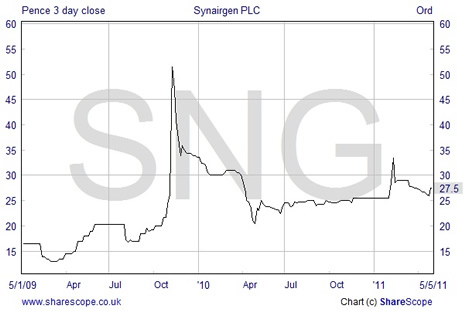
Aimzine is a FREE online magazine for investors and everyone involved with AIM companies. Register here to read this month's Aimzine |
With just two days to go to AimZine’s publication I must confess that I was struggling to find a suitable announcement to grace this regular AIM Snippet column. Then along came Synairgen (SNG) with a very interesting RNS on 4 May which indicated that this small AIM Company had discovered that its interferon beta protein ('IFN-β') is effective against H5N1 ('Bird Flu') in in vitro testing.
Synairgen is a respiratory drug discovery and development company with a particular focus on viral defence. We first featured this Company in September 2009 and then reported on a news item in a ‘Snippet’ article in June 2010. We would not normally return to the same company more than once for this ‘Snippet’ column, but I hope readers will agree that this news is of particular interest.
The Announcement
The following three paragraphs from Synairgen’s recent ‘Bird Flu’ RNS explain the research progress that the Company has made:
“Avian influenza, commonly called 'Bird Flu', is an infectious viral disease of birds. Most avian influenza viruses do not infect humans; however some, such as H5N1, have caused serious infections in humans (mortality rate of over 50%) and are a particular concern for influenza preparedness programmes.”
“In the experiments, Synairgen's IFN-beta protected human lung cells against infection with Bird Flu (virus strain: Influenza A/Indonesia/5/2005 (H5N1)). By the end of the experiments (48 hours after infection), approximately 100 times less Bird Flu virus had been released from cells treated with IFN-beta than those without IFN-beta.”
“IFN-beta acts by boosting the body's host cells' defences, rather than targeting a particular virus type. Synairgen has previously shown IFN-beta activity against rhinovirus (the most frequent cause of the common cold), respiratory syncytial virus (RSV), seasonal influenza and H1N1 (swine flu). There are relatively few therapeutic options for the treatment of highly pathogenic influenza strains such as H5N1 'Bird Flu'. These results indicate that IFN-beta beta may represent a future therapeutic option against a broad range of both common and less common, but highly pathogenic, viral threats.

At 31 December 2010 Synairgen reported that it had cash and bank deposit balances of £3.88 million and that cash burn for the second half of 2010 was £1.14 million. |
“”

Fortunately, I was able to speak to Synairgen’s Chief Executive, Richard Marsden, about this news. Richard was upbeat about this recent discovery and he stressed how important it was for progress to be made with Bird Flu which has such a high mortality rate. He went on to explain that the Company are progressing their influenza research, including the H5N1 strain, with the help of a Dutch research company. This research will include a series of more complex experiments and it is expected that results will be available by the end of the third quarter of this year. These results will help to determine the next steps for Synairgen in this area and could help to attract external funding support.
At a share price of 27.5 pence Synairgen has a market capitalisation of £16.4 million. |
Neuraminidase inhibitors
Each year there is a risk that the annual flu virus will develop into a serious pandemic. At present ‘neuraminidase inhibitor’ drugs such as Tamiflu and Relenza are available to combat the illness but these have serious limitations. Consequently both governments and large pharmaceutical companies are particularly keen to help to fund research in this area. One example of such funding was announced at the beginning of April this year, when the US Department of Health awarded a $230 million contract to Biota, an Australian drug development company. This contract is for the advanced development of ‘Laninamivir’, Biota’s neuraminidase inhibitor, over an estimated five year period; read Biota’s contract announcement here. Obviously Synairgen are not in a position to indicate that they will receive such funding but Richard could say that “this is certainly the space that 'IFN-β' could occupy”.
I asked Richard about Synairgen’s patent position with interferon beta ('IFN-β') as this protein has been used for some while in the treatment of multiple sclerosis. He explained that patents are available for a ‘new use’ of an existing drug and Synairgen has secured patents for the use of 'IFN-β' to treat rhinovirus infections in asthma and chronic obstructive pulmonary disease (COPD) and elderly patients (defined as over 40 years old!) for the treatment of rhinovirus. Synairgen has also applied for patents for the treatment of influenza in hospitalised patients - Synairgen’s core focus area is the very early treatment of ‘at risk’ hospitalised patients, which they consider to be a high value area.
Finally turning to Synairgen’s important on-going phase 2 proof of concept study into the treatment of respiratory viruses in asthma patients, Richard confirmed that this remained on schedule for the last patients to be dosed in the autumn during the peak of the ‘colds season’. He indicated that there should be an update on progress with the trial released in the coming weeks.
As always, the purpose of this Snippet column is to highlight an interesting situation worthy of further research and monitoring.

Richard Marsden
Copyright © Aimzine Ltd 2011
Return to: May AimZine Front Page
y without prior consent. ADVFN will BAN those who post AIMwithout prior permission.
| Recent Aim Snippets | |||||||||||||||||||||||||||||||||||||||||||||||||
|
|||||||||||||||||||||||||||||||||||||||||||||||||
This article is the copyright of Aimzine Ltd. No part of the article should be copied, reproduced, distributed or adapted in any way without our prior consent. |